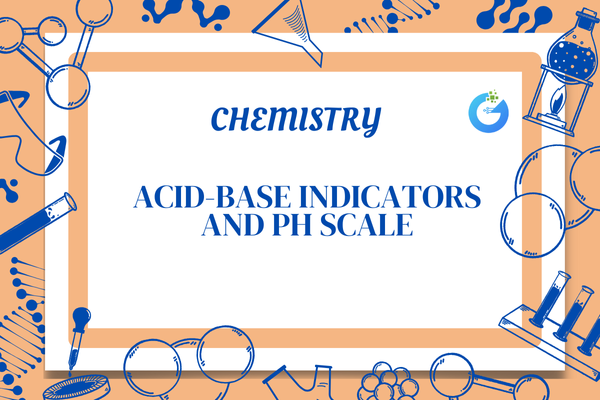Introduction
Have you ever tasted lemon juice and noticed its sourness? Or felt the slippery touch of soap while washing your hands? These everyday sensations are clues to the acidic or basic nature of substances! But how do scientists actually identify whether a substance is acidic or basic? That’s where acid-base indicators and the pH scale come in. These tools help us explore the chemical nature of various substances — safely, easily, and colorfully! Let’s explore this fascinating topic that connects chemistry with color, taste, and touch.
expert-led Chemistry classes – visit our website to learn more
What are Acids and Bases?
Acids are substances that taste sour, and they release hydrogen ions (H⁺) in water. Bases are substances that feel slippery and release hydroxide ions (OH⁻). Acids and bases are opposite in nature, and when they combine, they neutralize each other to form salt and water — a process called neutralization.
- Examples of Acids: Lemon juice, vinegar, hydrochloric acid (HCl)
- Examples of Bases: Soap, baking soda, sodium hydroxide (NaOH)
What are Indicators?
Indicators are special substances that change their color when added to acidic or basic solutions. They help us identify whether a substance is an acid or a base without tasting or touching it — which could be dangerous!
There are two main types of indicators:
- Natural indicators (obtained from plants)
- Synthetic indicators (made in labs)
Natural Indicators
Natural indicators are found in everyday plants and foods. They are safe to use and show clear color changes.
Common Natural Indicators:
- Litmus: Extracted from lichens. Turns red in acid, blue in base.
- Turmeric: Yellow in acid, reddish-brown in base.
- China rose (Hibiscus): Light pink in acid, green in base.
- Red cabbage juice: Purple in neutral, red in acid, green/yellow in base.
Synthetic Indicators
These are man-made indicators used in laboratories because of their accuracy and clear color changes.
Common Synthetic Indicators:
- Phenolphthalein: Colorless in acid, pink in base.
- Methyl orange: Red in acid, yellow in base.
- Bromothymol blue: Yellow in acid, blue in base.
What is the pH Scale?
The pH scale is a number line from 0 to 14 that tells us how acidic or basic a solution is. It stands for “potential of Hydrogen” and measures the concentration of hydrogen ions in a solution.
- pH less than 7: Acidic
- pH exactly 7: Neutral
- pH more than 7: Basic (alkaline)
pH Value Chart with Common Substances
| Substance | pH Value | Nature |
| Lemon juice | 2 | Strong acid |
| Vinegar | 3 | Weak acid |
| Pure water | 7 | Neutral |
| Baking soda | 9 | Weak base |
| Soap solution | 10 | Moderate base |
| Bleach | 13 | Strong base |
Why is pH Important?
pH plays a vital role in our daily lives and in the environment:
- In our body: Our stomach uses acid (pH ~1.5) to digest food.
- In farming: Soil pH affects crop growth.
- In water bodies: Aquatic life survives only in water with balanced pH.
- In medicine: Medicines are made to match the body’s pH levels.
Neutralization Reaction
When an acid and a base mix, they cancel each other’s effects. This is called a neutralization reaction. It forms salt and water and is used in many applications.
Example:
Hydrochloric acid (HCl) + Sodium hydroxide (NaOH) → Sodium chloride (salt) + Water
Applications of Indicators and pH in Daily Life
- Testing soil acidity for farming.
- Checking if water is safe to drink.
- Using antacids to reduce stomach acidity.
- Shampoo and skincare pH for gentle effect.
pH in the Environment
Pollution can change the pH of rain and rivers, leading to serious effects:
- Acid rain: pH drops below 5.6 due to air pollution — damages buildings, soil, and aquatic life.
- Alkaline water: Wastewater from factories increases pH — harms fish and plants.
Fun Facts About Acids, Bases, and pH
- Honey is slightly acidic (pH ~3.5) but tastes sweet!
- Our saliva’s pH changes during the day.
- Red cabbage juice is a natural, edible pH indicator.
- Soaps are basic, but shampoo is usually pH-neutral to avoid harming hair.
FAQs
What does pH stand for?
pH stands for “potential of Hydrogen.”
Which indicator is used in schools the most?
Litmus paper — it’s easy, safe, and colorful!
Is it safe to taste something to check if it’s acidic?
No! Always use indicators instead of tasting unknown substances.
What is the pH of human blood?
It is slightly basic, around 7.4.
Can I make indicators at home?
Yes! You can use turmeric, red cabbage, or hibiscus flowers.
Why are pH balanced shampoos good?
They don’t disturb the natural acidity of your scalp, keeping your hair healthy.
Conclusion
Acid-base indicators and the pH scale are essential tools in science. They help us understand the nature of substances — safely and easily. Whether it’s caring for our health, protecting the environment, or improving our daily products, pH plays a key role. With a little color and chemistry, we can measure and manage the invisible power of acids and bases all around us!









Great post. I was checking constantly this blog and
I’m inspired! Very helpful info specially the closing part
🙂 I deal with such information a lot. I used to be looking for this particular info youtube downloader for windows a very long time.
Thanks and good luck.